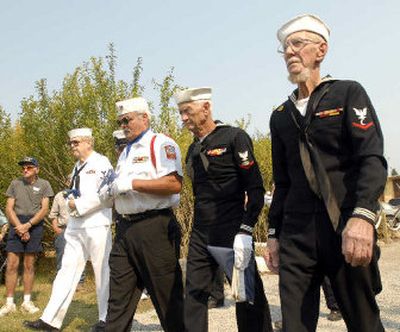Sailors hold final reunion

BAYVIEW, Idaho – Few traces remain of the Farragut Naval Training Station. A thick pine forest now grows where, nearly a lifetime ago, hundreds of thousands of young men learned to march, shoot and swim as they prepared for war.
Most of the barracks and buildings are gone, but a few of the old sailors remain. They’re meeting this weekend for one last time.
An estimated 400 veterans and their family members attended an opening ceremony and sculpture dedication Friday afternoon in front of the decommissioned naval station’s prison.
This is the 20th and final annual national reunion of Farragut sailors. Organizers say they are simply getting too old and tired to continue making the arrangements.
Out of 680 buildings that once dotted these grounds – the land has since been turned into a popular state park – the brigade is one of the few still standing. It now houses a historical museum.
A sculpture of a sailor will be positioned in front of the brigade museum. The sculptor, Coeur d’Alene artist David Clemons, told the veterans that his work was dedicated to “the virtues you stood for, the battles you fought and the America that you created.”
A total of 293,000 sailors were trained at Farragut between 1942 and 1946. Today, the youngest of these sailors – not including the handful of boys who lied about their age – would be 77.
Although a good number of the men leaned on canes or were tethered to oxygen tanks, many others appeared fit to head off to combat. A handful, including 79-year-old Tom Reilly, of Cavendish, Idaho, attended the reunion wearing original sailor uniforms. Reilly grew up on a North Dakota farm. He enlisted in the Navy in hopes of seeing an ocean.
“I got to see it,” he said. “Seven trips across the Pacific and two times across the Atlantic.”
On Friday, the sun was tinged amber from all the forest fire smoke. Many of the memories and stories recounted by the veterans also had a golden hue. After 60 years, the men say they would rather not dwell on the horrors of war or the anxieties of boot camp.
“To me, everything was perfect,” said Fred Seidel, of Chicago. “The Navy made a man out of me.”
The end of the reunions is clearly a point of sadness for those at Farragut this weekend.
“This is history in the raw,” said Henry Vanderwood, another veteran of the Pacific. “It’s a shame that it has to die out.”
Leon Woodworth, of Graham, Wash., said he never talked about serving as a gunner on a battleship in the Pacific until he started attending the reunions.
“These have been good for me,” said Woodworth, who also wore his 62-year-old uniform. But Woodworth wasn’t ready to call it quits yet. “This is not the last one. Us young guys are going to come back.”
Al Leiser, who worked at Farragut State Park and has been the main force behind the reunions, said only six men showed up for the first event 20 years ago. Thousands have attended since.
Leiser has since retired from his job at the park, but he continues to push for more recognition of the park’s role in training the most powerful navy on the planet. Idaho school children learn about the Cataldo Mission when they study state history, but “in none of those textbooks is there any mention of the Farragut Naval Station,” Leiser said.
On Friday, the war stories and training camp recollections flowed freely from dawn until long after the full moon rose over Lake Pend Oreille.
Many of the veterans were firsthand witnesses to some of the biggest battles in history.
Jeff Potter, of Shawnee, Okla., was serving as a baker aboard a troop carrier in the Pacific. Shortly after the ship dropped off a load of Marines on a desolate island, Potter was on the ship’s deck watching the distant battle. Amidst the chaos of battle, Potter saw a group of Marines raise a tattered American flag atop a hill. The island was Iwo Jima.
Serving on the ship with Potter was Rino Carbonari, of Spokane. Carbonari, a radarman, missed the famous flag raising, but he clearly recalls the eagerness of the young men to serve their country.
“We were just young kids who thought we were going to whoop the world,” said Carbonari, who wears a faded Popeye tattoo on his right forearm.
Sixty years later, few of the memories seemed to have faded. Including some of the sad ones.
Oscar Fields, now 80, recalled the anxiety he and his twin brother, Olliver, felt upon arriving at Farragut in August 1943. “We were apprehensive – hoping, even praying we’d come through the war OK,” Fields said.
The Fields twins survived some serious battles in the Pacific and returned home with barely a scratch. Olliver Fields tried to persuade his brother to stay in the military.
“Whatever he wanted, I would do,” Oscar Fields said. But Oscar wanted out of the service. “That was the first time I ever told him no.”
Fields’ eyes filled with tears when he told the story. He looked away. “Olliver went to fight in Korea. He got killed. He’s still there,” Oscar Fields said. “I miss him. Our young adult lives ended right here.”